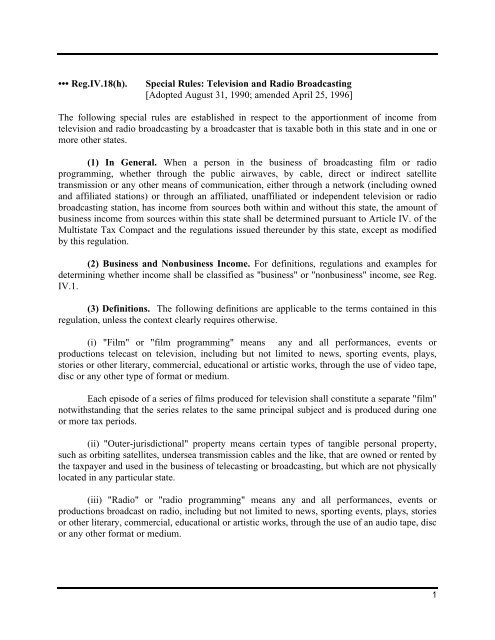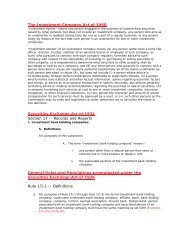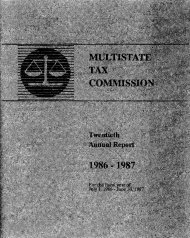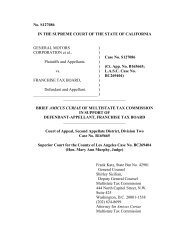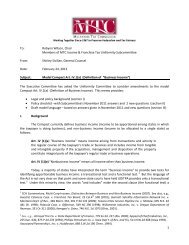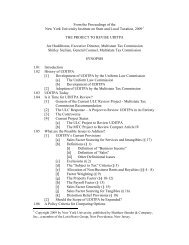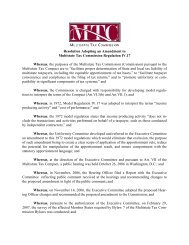Special Rules: Television and Radio Broadcasting - Multistate Tax ...
Special Rules: Television and Radio Broadcasting - Multistate Tax ...
Special Rules: Television and Radio Broadcasting - Multistate Tax ...
Create successful ePaper yourself
Turn your PDF publications into a flip-book with our unique Google optimized e-Paper software.
••• Reg.IV.18(h).<br />
<strong>Special</strong> <strong>Rules</strong>: <strong>Television</strong> <strong>and</strong> <strong>Radio</strong> <strong>Broadcasting</strong><br />
[Adopted August 31, 1990; amended April 25, 1996]<br />
The following special rules are established in respect to the apportionment of income from<br />
television <strong>and</strong> radio broadcasting by a broadcaster that is taxable both in this state <strong>and</strong> in one or<br />
more other states.<br />
(1) In General. When a person in the business of broadcasting film or radio<br />
programming, whether through the public airwaves, by cable, direct or indirect satellite<br />
transmission or any other means of communication, either through a network (including owned<br />
<strong>and</strong> affiliated stations) or through an affiliated, unaffiliated or independent television or radio<br />
broadcasting station, has income from sources both within <strong>and</strong> without this state, the amount of<br />
business income from sources within this state shall be determined pursuant to Article IV. of the<br />
<strong>Multistate</strong> <strong>Tax</strong> Compact <strong>and</strong> the regulations issued thereunder by this state, except as modified<br />
by this regulation.<br />
(2) Business <strong>and</strong> Nonbusiness Income. For definitions, regulations <strong>and</strong> examples for<br />
determining whether income shall be classified as "business" or "nonbusiness" income, see Reg.<br />
IV.1.<br />
(3) Definitions. The following definitions are applicable to the terms contained in this<br />
regulation, unless the context clearly requires otherwise.<br />
(i) "Film" or "film programming" means any <strong>and</strong> all performances, events or<br />
productions telecast on television, including but not limited to news, sporting events, plays,<br />
stories or other literary, commercial, educational or artistic works, through the use of video tape,<br />
disc or any other type of format or medium.<br />
Each episode of a series of films produced for television shall constitute a separate "film"<br />
notwithst<strong>and</strong>ing that the series relates to the same principal subject <strong>and</strong> is produced during one<br />
or more tax periods.<br />
(ii) "Outer-jurisdictional" property means certain types of tangible personal property,<br />
such as orbiting satellites, undersea transmission cables <strong>and</strong> the like, that are owned or rented by<br />
the taxpayer <strong>and</strong> used in the business of telecasting or broadcasting, but which are not physically<br />
located in any particular state.<br />
(iii) "<strong>Radio</strong>" or "radio programming" means any <strong>and</strong> all performances, events or<br />
productions broadcast on radio, including but not limited to news, sporting events, plays, stories<br />
or other literary, commercial, educational or artistic works, through the use of an audio tape, disc<br />
or any other format or medium.<br />
1
<strong>Multistate</strong> <strong>Tax</strong> Commission<br />
Each episode of a series of radio programming produced for radio broadcast shall<br />
constitute a separate "radio programming" notwithst<strong>and</strong>ing that the series relates to the same<br />
principal subject <strong>and</strong> is produced during one or more tax periods.<br />
(iv) "Release" or “in release” means the placing of film or radio programming into<br />
service. A film or radio program is placed into service when it is first broadcast to the primary<br />
audience for which the program was created. Thus, for example, a film is placed in service when<br />
it is first publicly telecast for entertainment, educational, commercial, artistic or other purpose.<br />
Each episode of a television or radio series is placed in service when it is first broadcast. A<br />
program is not placed in service merely because it is completed <strong>and</strong> therefore in a condition or<br />
state of readiness <strong>and</strong> availability for broadcast or, merely because it is previewed to prospective<br />
sponsors or purchasers.<br />
(v) "Rent" shall include license fees or other payments or consideration provided in<br />
exchange for the broadcast or other use of television or radio programming.<br />
(vi) A "subscriber" to a cable television system is the individual residence or other outlet<br />
which is the ultimate recipient of the transmission.<br />
(vii) "Telecast" or "broadcast" (sometimes used interchangeably with respect to<br />
television) means the transmission of television or radio programming, respectively, by an<br />
electronic or other signal conducted by radio waves or microwaves or by wires, lines, coaxial<br />
cables, wave guides, fiber optics, satellite transmissions directly or indirectly to viewers <strong>and</strong><br />
listeners or by any other means of communications.<br />
(4) Apportionment of Business Income.<br />
(i) In General. The property factor shall be determined in accordance with Regulation<br />
IV.10 through 12., the payroll factor in accordance with Regulation IV.13. <strong>and</strong> 14., <strong>and</strong> the sales<br />
factor in accordance with Regulation IV.15. <strong>and</strong> 16., except as modified by this regulation.<br />
(ii) The Property Factor.<br />
A. In General<br />
1. In the case of rented studios, the net annual rental rate shall include only the amount of<br />
the basic or flat rental charge by the studio for the use of a stage or other permanent equipment<br />
such as sound recording equipment <strong>and</strong> the like; except that additional equipment rented from<br />
other sources or from the studio not covered in the basic or flat rental charge <strong>and</strong> used for one<br />
week or longer (even though rented on a day-to-day basis) shall be included. Lump-sum net<br />
rental payments for a period which encompasses more than a single income year shall be<br />
assigned ratably over the rental period.<br />
2 Regulations, Statutes, <strong>and</strong> Guidelines
2. No value or cost attributable to any outerjurisdictional, film or radio programming<br />
property shall be included in the property factor at any time.<br />
B. Property Factor Denominator.<br />
1. All real property <strong>and</strong> tangible personal property (other than outer-jurisdictional <strong>and</strong><br />
film or radio programming property), whether owned or rented, which is used in the business<br />
shall be included in the denominator of the property factor.<br />
2. Audio or video cassettes, discs or similar medium containing film or radio<br />
programming <strong>and</strong> intended for sale or rental by the taxpayer for home viewing or listening shall<br />
be included in the property factor at their original cost. To the extent that the taxpayer licenses or<br />
otherwise permits others to manufacture or distribute such cassettes, discs or other medium<br />
containing film or radio programming for home viewing or listening, the value of said cassettes,<br />
discs or other medium shall include the license, royalty or other fees received by the taxpayer<br />
capitalized at a rate of eight times the gross receipts derived therefrom during the income year.<br />
3. Outer-jurisdictional, film <strong>and</strong> radio programming property shall be excluded from the<br />
denominator of the property factor.<br />
C. Property Factor Numerator.<br />
1. With the exception of outer-jurisdictional, film <strong>and</strong> radio programming property, all<br />
real <strong>and</strong> tangible personal property owned or rented by the taxpayer <strong>and</strong> used in this state during<br />
the tax period shall be included in the numerator of the property factor as provided in Regulation<br />
IV.10.(d).<br />
2. Outer-jurisdictional, film <strong>and</strong> radio programming property shall be excluded from the<br />
numerator of the property factor.<br />
Example: XYZ <strong>Television</strong> Co. has a total value of all of its property everywhere of<br />
$500,000,000, including a satellite valued at $50,000,000 that was used to telecast programming<br />
into this state <strong>and</strong> $150,000,000 in film property of which $1,000,000's worth was located in this<br />
state the entire year. The total value of real <strong>and</strong> tangible personal property, other than film<br />
programming property, located in this state for the entire income year was valued at $2,000,000;<br />
<strong>and</strong> the movable <strong>and</strong> mobile property described in subparagraph C.1. was determined to be of a<br />
value of $4,000,000 <strong>and</strong> such movable <strong>and</strong> mobile property was used in this state for 100 days.<br />
The total value of property to be attributed to this state would be determined as follows:<br />
3
<strong>Multistate</strong> <strong>Tax</strong> Commission<br />
Value of property permanently in state: $2,000,000<br />
Value of mobile <strong>and</strong> movable property:<br />
(100/365 or .2739 x $4,000,000): $1,095,600<br />
Total value of property to be included in<br />
the state's property factor numerator<br />
(outer-jurisdictional <strong>and</strong> film property<br />
excluded): $3,095,600<br />
Total value of property to be used in the<br />
denominator ($500,000,000-$200,000,000) $300,000,000<br />
Total property factor ($3,095,600/$300,000,000): .0103<br />
(iii) The Payroll Factor.<br />
A. Payroll Factor Denominator.<br />
The denominator of the payroll factor shall include all compensation, including residual<br />
<strong>and</strong> profit participation payments, paid to employees during the income year, including that paid<br />
to directors, actors, newscasters <strong>and</strong> other talent in their status as employees.<br />
B. Payroll Factor Numerator.<br />
Compensation for all employees shall be attributed to the state or states as may<br />
determined by the application of the provisions of Reg.IV.13. <strong>and</strong> 14.<br />
(iv) The Sales Factor.<br />
A. Sales Factor Denominator.<br />
The denominator of the sales factor shall include the total gross receipts derived by the<br />
taxpayer from transactions <strong>and</strong> activity in the regular course of its trade or business, except<br />
receipts excluded under Reg.IV.18.(c).<br />
B. Sales Factor Numerator.<br />
The numerator of the sales factor shall include all gross receipts of the taxpayer from<br />
sources within this state, including, but not limited to the following:<br />
1. Gross receipts, including advertising revenue, from television film or radio<br />
programming in release to or by television <strong>and</strong> radio stations located in this state.<br />
4 Regulations, Statutes, <strong>and</strong> Guidelines
2. Gross receipts, including advertising revenue, from television film or radio<br />
programming in release to or by a television station (independent or unaffiliated) or network of<br />
stations for broadcast shall be attributed to this state in the ratio (hereafter "audience factor") that<br />
the audience for such station (or owned <strong>and</strong> affiliated stations in the case of networks) located in<br />
this state bears to the total audience for such station (or owned <strong>and</strong> affiliated stations in the case<br />
of networks).<br />
The audience factor for television or radio programming shall be determined by the ratio<br />
that the taxpayer's in-state viewing (listening) audience bears to its total viewing (listening)<br />
audience. Such audience factor shall be determined either by reference to the books <strong>and</strong> records<br />
of the taxpayer or by reference to published rating statistics, provided the method used by the<br />
taxpayer is consistently used from year to year for such purpose <strong>and</strong> fairly represents the<br />
taxpayer’s activity in the state.<br />
3. Gross receipts from film programming in release to or by a cable television system<br />
shall be attributed to this state in the ratio (hereafter "audience factor") that the subscribers for<br />
such cable television system located in this state bears to the total subscribers of such cable<br />
television system. If the number of subscribers cannot be accurately determined from the books<br />
<strong>and</strong> records maintained by the taxpayer, such audience factor ratio shall be determined on the<br />
basis of the applicable year's subscription statistics located in published surveys, provided that<br />
the source selected is consistently used from year to year for that purpose.<br />
4. Receipts from the sale, rental, licensing or other disposition of audio or video<br />
cassettes, discs, or similar medium intended for home viewing or listening shall be included in<br />
the sales factor as provided in Reg. IV. 16.<br />
5


